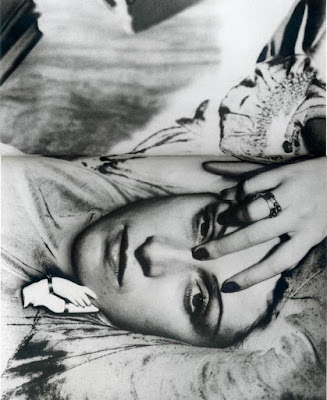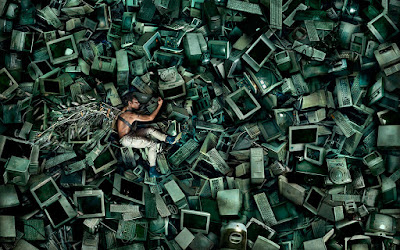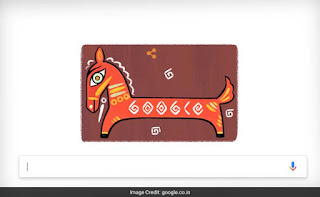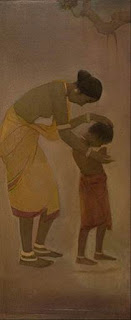The 'Reality' of Photo Art Today
by
Shibu Arakkal
“The greater the number of people who share a subjective opinion in favour of a work of art, the greater the possibility of that work becoming timeless”
 |
| Hiroshi Sugimoto Boden Sea |
This article is my response to John Raymond Mireles’ article on petapixel.com titled ‘Why Photographers Don’t Get Modern Art’, which I found touched on many aspects of Contemporary Art which are close to my heart.
Before I make my way to contemporary photographic art, I would like to mention my dad’s (Yusuf Arakkal) words (possibly someone else’s originally), who is no more and someone who was one of the very significant and relevant contemporary artists from post-independence India. He used to say that any work of art will only be judged by time and no one else. Much as I too believe that, the statement also seems to put current art in a bit of a quandary in the sense of what is widely agreeable, certainly about the credibility and calibre of art done over the last thirty odd years. As Mireles points out that most of the art done over this period, varying in styles and mediums has been rather vaguely termed Post-modernist. Noting Mireles’ article, the most common statement a lot of this kind of art has been faced with from its popular audience is ‘I could have done that too’, to which I go back to what my dad used to say, ‘But you didn’t’.
If I were to name widely agreed-upon greats as Michelangelo, Da Vinci, Rembrandt, Salvador Dali of a few, I would quite confidently say that there would be little subjectivity about the ‘great’ calibre of their work, not just in the art world but even with the art literate. This level of consensus on a type or specificity of art, I fear often comes after the artist’s time and in his day leads to much debate and quarrel about the true ‘greatness’ or calibre of the art itself.
 |
| Edward Steichen's 'Road into the Valley' | Negative 1904 / Print 1906 |
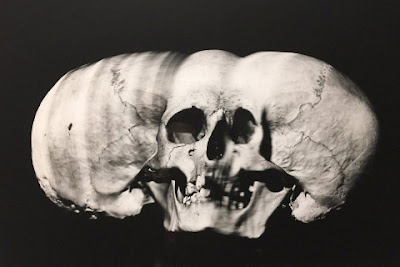 |
| Irving Penn's Skulls | Late 1970s |
 |
| Bill Brandt's 'Coal Searcher Going Home to Jarrow' | 1937 |
Up until the point when photography arrived on the scene, painting seemed to be the most ‘realistic’ art form but it obviously couldn’t compete with photography in that department. From then on painting seemed to get fervently preoccupied with philosophical and conceptual interpretations of reality in their widest as well as technical sense.
 |
| Annie Leibovitz | The Three Ghosts |
As Mireles mentions, stalwarts like Ansel Adams became the leaders of a modernist movement in photography, creating a style while crafting techniques that are relevant to this day.
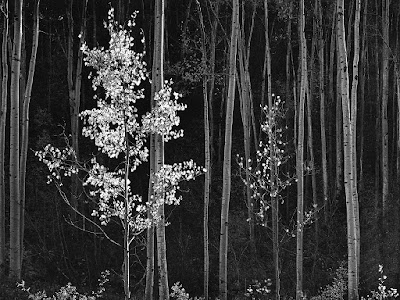 |
| Ansel Adams | Aspens Northern New Mexico | 1958 |
Until recently all two-dimensional visual art forms aiming to recreate or interpret reality have incorporated visually appreciable elements such as the subjective use of colour and contrast, creating an idea of composition relative to the viewing frame of the work itself, the use of lighting as an image enhancing element, amongst other things. This approach made the artwork distinctly ‘artistic' as opposed to faithfully realistic.
Even Photorealism in painting was a visual depiction of the way the camera or the lens saw reality with all the subjective artistic enhancements.
In photography, from Pictorialism to Modernism there was always a conscious effort made to heighten, if not strengthen these aspects of a photograph that made it more appreciable albeit not very realistic. To the point, that true realism was never seen as very interesting a visual idea.
With all art that is very ‘now’ such as a lot of new media or contemporary experimental work, I can’t honestly tell if the demand is due to the hype, which seems to be almost critical to the success of the work or if it is just the reality of the market. I do however feel strongly that in years to come, classical ideas of photography will stand on its own, even if in its own niche. And I think will also be regarded for its unique sensibility and aesthetic, simply because it has a visually rich tradition and processes, unlike any other print medium.
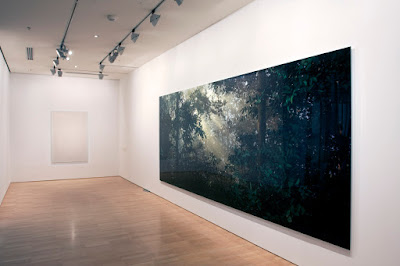 |
| Thomas Demand's 'Clearing' | Gallery Display |
 |
| Thomas Demand's 'Clearing' | Venice Biennale Display |
I see photography's lead into new styles (or movements, we wait to find out) in the digital era that are either a very real interpretation of reality, visually faithful, devoid of artistic enhancements i.e. as the human memory remembers a seen visual, one that tries to harness the power of that memory and to somehow remain austere of those luxuries that we once considered appreciable, even fundamental.
Or tangentially giving rise to a concept such as Hyperrealism, where using, while pushing the boundaries, every available digitally technological means in creating images that are almost too sharp, with colour and contrast in their widest gamut ever seen in the history of photography. And to use photographs in their singular form or as multiples in stitching together, morphing, layering or making seamless digital collages that give one an illusion of a visual that could be real but isn’t really. Hyperrealism in its most experimental techniques challenges dimensions, the vertical and horizontal axes, space and in ways, time and fundamentally obliterates our secure bearings of visual comprehension. It is as much to be understood as accepted that photo editing and processing software from here on will be considered legitimately complimentary tools to photography and not as has been, an unholy convenience or an impurity in the process. This is especially where my views differ from those of Mireles’.
 |
| Lee Jeffries' Hyperrealistic Series on Homeless Children |
The new wave of western painters seem to already have eagerly embraced these two styles of visual interpretation and will hopefully further the basic premise and idea with more freedom. Especially given that painting unlike photography doesn't have the constraints of working with subjects that are already existent.
---------------------------------------------------------------------------------------------------------------
About the Author: Shibu Arakkal is a ‘Lorenzo il Magnifico’ Gold Prize winning photo artist, based in Bangalore, who has practised his art for over twenty years, and has shown his work extensively in India and abroad. One might bump into him riding his motorcycle, or cross paths with him while he is satiating his travel yearnings. He is a self-admitted dog-lover and philosopher inspired always by his daughter Zarah. You can connect with him on facebook.com/
All images are for reference purposes and have been sourced by the author from the Internet, mainly from the artists' websites, Facebook and Pinterest pages. Please view image details for the source.
